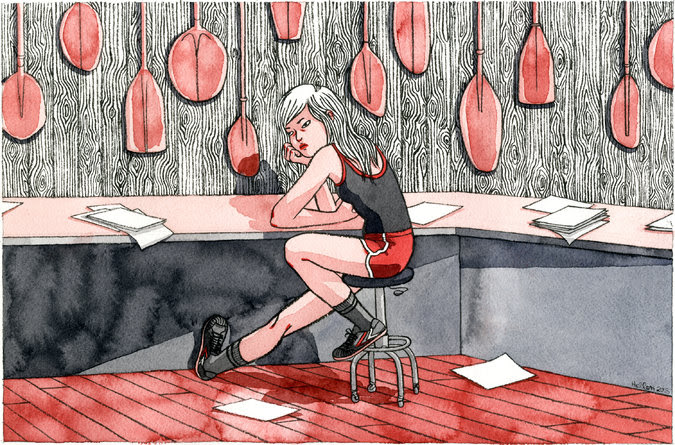
The Other Side of Boredom
By MARY MANN APRIL 18, 2015
Alone with my boredom, discovered the Internet. I dove into Wikipedia, surfacing periodically, triumphantly, with a fresh catch: Morita therapy, Viola Spolin, Emperor Norton, stellar parallax.
One of the first things the Internet taught me was that I wasn’t alone in having nothing to do. Millions were paid to stand around, forced into inactivity by potential customers’ reluctance to spend, reminding ourselves that we were lucky just to be employed. Retail salespeople, tour guides and hotel clerks, waitresses and cooks and dishwashers and bartenders — we were everywhere, and we had a lot of time on our hands.
The do-nothing job didn’t begin or end with the recession. The service sector is one of the largest and fastest growing in the world, and even in the best of times, the level of activity for many of these jobs fluctuates with the seasons and the weather. And of course many service sector employees aren’t allowed to check their phones or listen to music, let alone surf the Internet all day.
Doing nothing is often boring, and boredom is often crazy-making.
In a 2014 study, published in the journal Science, researchers reported that many people preferred self-administering electric shocks to doing nothing.
Yet, astoundingly, others actively seek boredom out.
“You have to sit around so much doing nothing,” Gertrude Stein wrote on developing creative genius.
F. Scott Fitzgerald thought boredom was necessary for writing: “You’ve got to go by or past or through boredom, as through a filter, before the clear product emerges.”
The poet Mary Ruefle speaks of “the vital necessity of wasting time, of loafing and doing nothing.”
Two recent studies lend scholarly weight to such claims: People who have been bored demonstrate increased creativity, and are better at associative thinking than those who have just been relaxing.
For every Whitman loafing at his ease, there’s someone else deeply depressed by the specter of empty time.
Boredom seems to result in creativity only when given the right conditions.
Yet at the same time, creative thinking is what makes boredom tolerable: A factory employee dreams up home redecorations on the assembly line, a salmon fisherwoman plans the evening menu while hauling nets, a medical salesman decides in a meeting to start raising bees.
So what turns doing nothing into creative fuel?
While there are no conclusive studies on this, therapists and psychoanalysts I’ve interviewed tend to agree that the best way to really use boredom is to allow our bored minds to wander freely and to pay close attention to where they go, like watching a Ouija board supply answers under our own fingertips.
For me, alone in a kayak shop in 2009, that Ouija board was the Internet.
Sometimes boredom serves as empty ground on which to build new ideas, while other times it acts as a guide to our true desires. You have to wait and see; above all, boredom is the master of the long con.
It took two years, but eventually I realized that kayak guiding — the little I was doing of it, anyway — had become far less enjoyable than exploring the Internet.
There was so much to know. And it was all at my fingertips.
In 2010 I left San Diego and moved to New York, where I eventually found work as a researcher. Research, like the path I took to it, is all about delayed gratification.
My days are spent spelunking in online archives or tracking down sources in the library stacks. The work is often objectively tedious but rarely feels that way, because I know what’s coming: Those crackling jolts of discovery I once believed could be found only in the wilderness are now achieved when my sleuthing uncovers elusive, idea-shaping information.
Mary Mann is a freelance writer and researcher who is working on a book about boredom.
A version of this op-ed appears in print on April 19, 2015, on page SR6 of the New York edition with the headline: The Other Side of Boredom.
No comments:
Post a Comment